Solar Energy Potential in the Yangtze River Delta Region—A GIS-Based Assessment
Abstract
1. Introduction
2. Study Area
3. Methodology
3.1. Solar Potential Evaluation
3.1.1. Geographical Potential
3.1.2. Technical Potential
- Photovoltaic cells that use the technology of crystalline silicon: monocrystalline silicon and in the multicrystalline form: polycrystalline silicon
- Thin film cells which are generally grouped into: amorphous silicon, cadmium telluride, copper indium selenide and copper and indium-gallium dieseline.
- Organic solar cells
- Dye-sensitized solar cells
- Compounds III–V solar cells in which nanotechnology is applied in the development of the solar cells
- Crystal silicon solar cells are predominant in the PV market with the market share of monocrystalline solar cells at about 80% [37].
3.1.3. Solar Radiation Data
4. Results and Discussion
4.1. Land Suitability
4.2. Geographical Solar Potential
4.3. Technical Solar Potential
5. Case Study: Shenzhen Energy Solar PV Power Plant
6. Conclusions
- (1)
- The YRDR is endowed with rich solar resources with geographical solar energy potential in the suitable areas varying spatially from 1446 kWh/m2 to 1658 kWh/m2, illustrating the sufficient solar energy resources available.
- (2)
- The maximum solar capacity potential could be up to 4140.5 GW, which is equivalent to 98.85 times the total cumulative installed capacity in the YRDR at the end of 2019, showing the large potential that still exists for future development.
- (3)
- The technical solar energy potential is very high, at an estimated value of 7550 TWh, which corresponds to 5.22 times the total electricity consumption in the YRDR in 2018, characterizing the significant potential available that can meet the YRDR power needs, turn the YRDR into an exporter of electricity and substantially mitigate CO2 emissions if the potential is fully realized.
- (4)
- Jiangsu and Anhui provinces provide the most optimal areas for the construction of utility-scale solar PV installations as they have the highest geographical and technological solar energy potential.
- (5)
- The disparities between actual GP and potential GP observed in the PV plant used as a case study highlight the significance of utilizing solar radiation data from local ground-based meteorological stations for the estimation of technical solar energy potential.
Author Contributions
Funding
Institutional Review Board Statement
Informed Consent Statement
Data Availability Statement
Acknowledgments
Conflicts of Interest
Abbreviations
| YRDR | Yangtze River Delta region |
| PV | photovoltaics |
| GP | technical solar potential; the potential electric generation power |
| GHI | global horizontal irradiance |
| potential GP | potential electric generation power |
| actual GP | actual electric generated power |
| NASA SSE | National Aeronautics and Space Administration Surface Meteorology and Solar Energy program |
References
- Prakash, R.; Bhat, I.K. Energy, economics and environmental impacts of renewable energy systems. Renew. Sustain. Energy Rev. 2009, 13, 2716–2721. [Google Scholar]
- Sampaio, P.G.V.; González, M.O.A. Photovoltaic solar energy: Conceptual framework. Renew. Sustain. Energy Rev. 2017, 74, 590–601. [Google Scholar] [CrossRef]
- Razykov, T.M.; Ferekides, C.S.; Morel, D.; Stefanakos, E.; Ullal, H.S.; Upadhyaya, H.M. Solar photovoltaic electricity: Current status and future prospects. Sol. Energy 2011, 85, 1580–1608. [Google Scholar] [CrossRef]
- United Nations. UNFCCC Conference of the Parties: Adoption of the Paris Agreement; FCCC/CP/2015/10Add.1; United Nations: Paris, France, 2015; pp. 1–32. [Google Scholar]
- Fang, H.; Li, J.; Song, W. Sustainable site selection for photovoltaic power plant: An integrated approach based on prospect theory. Energy Convers. Manag. 2018, 174, 755–768. [Google Scholar] [CrossRef]
- Colak, H.E.; Memisoglu, T.; Gercek, Y. Optimal site selection for solar photovoltaic (PV) power plants using GIS and AHP: A case study of Malatya Province, Turkey. Renew. Energy 2020, 149, 565–576. [Google Scholar] [CrossRef]
- International Energy Agency (IEA). Photovoltaic Power Systems Programme, Report IEA-PVPS T1-37:2020. Available online: https://iea-pvps.org/wp-content/uploads/2020/04/IEA_PVPS_Snapshot_2020.pdf (accessed on 11 November 2020).
- Sun, Y.-W.; Hof, A.; Wang, R.; Liu, J.; Lin, Y.-J.; Yang, D.-W. GIS-based approach for potential analysis of solar PV generation at the regional scale: A case study of Fujian Province. Energy Policy 2013, 58, 248–259. [Google Scholar] [CrossRef]
- Sun, Y.; Wang, R.; Li, J.; Liu, J. GIS-based multiregional potential evaluation and strategies selection framework for various renewable energy sources: A case study of eastern coastal regions of China. Energy Sci. Eng. 2017, 5, 123–140. [Google Scholar] [CrossRef]
- Yang, Q.; Huang, T.; Wang, S.; Li, J.; Dai, S.; Wright, S.; Wang, Y.; Peng, H. A GIS-based high spatial resolution assessment of large-scale PV generation potential in China. Appl. Energy 2019, 247, 254–269. [Google Scholar] [CrossRef]
- Zhang, Y.; Ren, J.; Pu, Y.; Wang, P. Solar energy potential assessment: A framework to integrate geographic, technological, and economic indices for a potential analysis. Renew. Energy 2020, 149, 577–586. [Google Scholar] [CrossRef]
- Liu, J.; Xu, F.; Lin, S. Site selection of photovoltaic power plants in a value chain based on grey cumulative prospect theory for sustainability: A case study in Northwest China. J. Clean. Prod. 2017, 148, 386–397. [Google Scholar] [CrossRef]
- Charabi, Y.; Gastli, A. PV site suitability analysis using GIS-based spatial fuzzy multi-criteria evaluation. Renew. Energy 2011, 36, 2554–2561. [Google Scholar] [CrossRef]
- Doorga, J.R.; Rughooputh, S.D.; Boojhawon, R. Multi-criteria GIS-based modelling technique for identifying potential solar farm sites: A case study in Mauritius. Renew. Energy 2019, 133, 1201–1219. [Google Scholar] [CrossRef]
- Yushchenko, A.; De Bono, A.; Chatenoux, B.; Patel, M.K.; Ray, N. GIS-based assessment of photovoltaic (PV) and concentrated solar power (CSP) generation potential in West Africa. Renew. Sustain. Energy Rev. 2018, 81, 2088–2103. [Google Scholar] [CrossRef]
- Dinesh, H.; Pearce, J.M. The potential of agrivoltaic systems. Renew. Sustain. Energy Rev. 2016, 54, 299–308. [Google Scholar] [CrossRef]
- Marrou, H.; Guilioni, L.; Dufour, L.; Dupraz, C.; Wéry, J. Microclimate under agrivoltaic systems: Is crop growth rate affected in the partial shade of solar panels? Agric. For. Meteorol. 2013, 177, 117–132. [Google Scholar] [CrossRef]
- Marrou, H.; Wéry, J.; Dufour, L.; Dupraz, C. Productivity and radiation use efficiency of lettuces grown in the partial shade of photovoltaic panels. Eur. J. Agron. 2013, 44, 54–66. [Google Scholar] [CrossRef]
- Schindele, S.; Trommsdorff, M.; Schlaak, A.; Obergfell, T.; Bopp, G.; Reise, C.; Braun, C.; Weselek, A.; Bauerle, A.; Högy, P. Implementation of agrophotovoltaics: Techno-economic analysis of the price-performance ratio and its policy implications. Appl. Energy 2020, 265, 114737. [Google Scholar] [CrossRef]
- Barron-Gafford, G.A.; Pavao-Zuckerman, M.A.; Minor, R.L.; Sutter, L.F.; Barnett-Moreno, I.; Blackett, D.T.; Thompson, M.; Dimond, K.; Gerlak, A.K.; Nabhan, G.P. Agrivoltaics provide mutual benefits across the food–energy–water nexus in drylands. Nat. Sustain. 2019, 2, 848–855. [Google Scholar] [CrossRef]
- Adeh, E.H.; Good, S.P.; Calaf, M.; Higgins, C.W. Solar pV power potential is Greatest over croplands. Sci. Rep. 2019, 9, 11442. [Google Scholar] [CrossRef]
- Wu, J.; Wei, Y.D.; Li, Q.; Yuan, F. Economic transition and changing location of manufacturing industry in China: A study of the Yangtze River Delta. Sustainability 2018, 10, 2624. [Google Scholar] [CrossRef]
- The State Council of the People’s Republic of China. Outline of the Yangtze River Delta Regional Integration Development Plan. 2019. Available online: www.gov.cn/zhengce/2019-12/01/content_5457442.htm (accessed on 12 November 2020).
- Movellan, J. Japan Next-Generation Farmers Cultivate Crops and Solar Energy. 2013. Available online: https://www.renewableenergyworld.com/2013/10/10/japan-next-generation-farmers-cultivate-agriculture-and-solar-energy/ (accessed on 12 December 2020).
- Jain, A.; Das, P.; Yamujala, S.; Bhakar, R.; Mathur, J. Resource Potential and Variability Assessment of Solar and Wind Energy in India. Energy 2020, 211, 118993. [Google Scholar] [CrossRef]
- Phadke, A.; Bharvirkar, R.; Khangura, J. Reassessing Wind Potential Estimates for India: Economic and Policy Implications; Lawrence Berkeley National Lab. (LBNL): Berkeley, CA, USA, 2011.
- Al Garni, H.Z.; Awasthi, A. Solar PV power plant site selection using a GIS-AHP based approach with application in Saudi Arabia. Appl. Energy 2017, 206, 1225–1240. [Google Scholar] [CrossRef]
- National Ministry of Land and Resources of the People’s Republic of China. Photovoltaic Power Plant Project Land Use Control Indicators. 2016. Available online: http://mlr.gov.cn/zwgk/zfgkml/gkml_9184/201512/t20151211_1391339.htm (accessed on 13 November 2020).
- International Centre for Tropical Agriculture. Hole-Filled Seamless SRTM Data Version 4. Available online: http://srtm.csi.cgiar.org/ (accessed on 1 November 2020).
- GADM. Available online: https://gadm.org/download_country_v3.html (accessed on 1 November 2020).
- WWF Global Lakes and Wetlands Database. Available online: https://www.worldwildlife.org/pages/global-lakes-and-wetlands-database (accessed on 1 November 2020).
- UNEP-WCMC; IUCN. Protected Planet: The World Database on Protected Areas (WDPA) [Online], September 2020; UNEP-WCMC and IUCN: Cambridge, UK, 2020; Available online: https://www.protectedplanet.net (accessed on 1 November 2020).
- Natural Earth Urban Areas. Available online: https://www.naturalearthdata.com/downloads/50m-cultural-vectors/50m-urban-areas/ (accessed on 1 November 2020).
- DIVA-GIS Spatial Data Download. Available online: https://www.diva-gis.org/datadown (accessed on 1 November 2020).
- ESA Data User Element. Available online: http://due.esrin.esa.int/page_globcover.php (accessed on 1 November 2020).
- Lacerda, J.S.; Van Den Bergh, J.C. Diversity in solar photovoltaic energy: Implications for innovation and policy. Renew. Sustain. Energy Rev. 2016, 54, 331–340. [Google Scholar] [CrossRef]
- Tyagi, V.; Rahim, N.A.; Rahim, N.; Jeyraj, A.; Selvaraj, L. Progress in solar PV technology: Research and achievement. Renew. Sustain. Energy Rev. 2013, 20, 443–461. [Google Scholar] [CrossRef]
- Green, M.A.; Dunlop, E.D.; Levi, D.H.; Hohl-Ebinger, J.; Yoshita, M.; Ho-Baillie, A.W. Solar cell efficiency tables (version 54). Prog. Photovolt. Res. Appl. 2019, 27, 565–575. [Google Scholar] [CrossRef]
- Li, D.; Liu, G.; Liao, S. Solar potential in urban residential buildings. Sol. Energy 2015, 111, 225–235. [Google Scholar] [CrossRef]
- Khan, G.; Rathi, S. Optimal site selection for solar PV power plant in an Indian state using geographical information system (GIS). Int. J. Emerg. Eng. Res. Technol. 2014, 2, 260–266. [Google Scholar]
- Broesamle, H.; Mannstein, H.; Schillings, C.; Trieb, F. Assessment of solar electricity potentials in North Africa based on satellite data and a geographic information system. Sol. Energy 2001, 70, 1–12. [Google Scholar] [CrossRef]
- Djebbar, R.; Belanger, D.; Boutin, D.; Weterings, E.; Poirier, M. Potential of concentrating solar power in Canada. Energy Procedia 2014, 49, 2303–2312. [Google Scholar] [CrossRef]
- Gastli, A.; Charabi, Y. Siting of large PV farms in Al-Batinah region of Oman. In Proceedings of the 2010 IEEE international energy conference, Manama, Bahrain, 18–22 December 2010; pp. 548–552. [Google Scholar]
- National Renewable Energy Laboratory (NREL). PVWatts® Calculator; Alliance for Sustainable Energy, LLC.: Golden, CO, USA, 2020. Available online: http://pvwatts.nrel.gov (accessed on 12 December 2020).
- Clifton, J.; Boruff, B.J. Assessing the potential for concentrated solar power development in rural Australia. Energy Policy 2010, 38, 5272–5280. [Google Scholar] [CrossRef]
- Fick, S.E.; Hijmans, R.J. WorldClim 2: New 1-km spatial resolution climate surfaces for global land areas. Int. J. Climatol. 2017, 37, 4302–4315. [Google Scholar] [CrossRef]
- International Renewable Energy Agency. IRENA Unleashing the Solar Potential in ECOWAS: Seeking Areas of Opportunity for Grid-Connected and Decentralised PV Applications; An Opportunity-Based Approach; International Renewable Energy Agency: Abu Dhabi, UAE, 2013. [Google Scholar]
- Anwarzai, M.A.; Nagasaka, K. Utility-scale implementable potential of wind and solar energies for Afghanistan using GIS multi-criteria decision analysis. Renew. Sustain. Energy Rev. 2017, 71, 150–160. [Google Scholar] [CrossRef]
- Ong, S.; Campbell, C.; Denholm, P.; Margolis, R.; Heath, G. Land-Use Requirements for Solar Power Plants in the United States; National Renewable Energy Lab. (NREL): Golden, CO, USA, 2013. [Google Scholar]
- China Energy Council. Available online: https://cec.org.cn/ (accessed on 19 November 2020).
- The State Council of the People’s Republic of China. Three-Year Action Plan to Win the “Blue Sky Defence War”. 2018. Available online: http://www.gov.cn/zhengce/2018-07/13/content_5306045.htm (accessed on 11 November 2020).
- The State Council of the People’s Republic of China. Air Pollution Prevention and Control Action Plan. 2013. Available online: http://www.gov.cn/zwgk/2013-09/12/content_2486773.htm (accessed on 11 November 2020).
- China Statistical Yearbook 2019. Available online: http://www.stats.gov.cn/tjsj/ndsj/2019/indexeh.htm (accessed on 19 November 2020).
- He, G.; Kammen, D.M.J.R.E. Where, when and how much solar is available? A provincial-scale solar resource assessment for China. Renew. Energy 2016, 85, 74–82. [Google Scholar] [CrossRef]
- Bergin, M.H.; Ghoroi, C.; Dixit, D.; Schauer, J.J.; Shindell, D.T. Large reductions in solar energy production due to dust and particulate air pollution. Environ. Sci. Technol. Lett. 2017, 4, 339–344. [Google Scholar] [CrossRef]
- Elminir, H.K.; Ghitas, A.E.; Hamid, R.; El-Hussainy, F.; Beheary, M.; Abdel-Moneim, K.M. Effect of dust on the transparent cover of solar collectors. Energy Convers. Manag. 2006, 47, 3192–3203. [Google Scholar] [CrossRef]
- Li, X.; Wagner, F.; Peng, W.; Yang, J.; Mauzerall, D.L. Reduction of solar photovoltaic resources due to air pollution in China. Proc. Natl. Acad. Sci. USA 2017, 114, 11867–11872. [Google Scholar] [CrossRef]
- Mani, M.; Pillai, R. Impact of dust on solar photovoltaic (PV) performance: Research status, challenges and recommendations. Renew. Sustain. Energy Rev. 2010, 14, 3124–3131. [Google Scholar] [CrossRef]
- Huang, T.; Wang, S.; Yang, Q.; Li, J. A GIS-based assessment of large-scale PV potential in China. Energy Procedia 2018, 152, 1079–1084. [Google Scholar] [CrossRef]
- He, G.; Zhou, C.; Li, Z. Review of self-cleaning method for solar cell array. Procedia Eng. 2011, 16, 640–645. [Google Scholar] [CrossRef]
- Vrînceanu, A.; Grigorescu, I.; Dumitrașcu, M.; Mocanu, I.; Dumitrică, C.; Micu, D.; Kucsicsa, G.; Mitrică, B. Impacts of photovoltaic farms on the environment in the Romanian plain. Energies 2019, 12, 2533. [Google Scholar] [CrossRef]
- Amaducci, S.; Yin, X.; Colauzzi, M. Agrivoltaic systems to optimise land use for electric energy production. Appl. Energy 2018, 220, 545–561. [Google Scholar] [CrossRef]
- Ravi, S.; Macknick, J.; Lobell, D.; Field, C.; Ganesan, K.; Jain, R.; Elchinger, M.; Stoltenberg, B. Colocation opportunities for large solar infrastructures and agriculture in drylands. Appl. Energy 2016, 165, 383–392. [Google Scholar] [CrossRef]
- Hassanpour Adeh, E.; Selker, J.S.; Higgins, C.W. Remarkable agrivoltaic influence on soil moisture, micrometeorology and water-use efficiency. PLoS ONE 2018, 13, e0203256. [Google Scholar] [CrossRef] [PubMed]
- Cossu, M.; Murgia, L.; Ledda, L.; Deligios, P.A.; Sirigu, A.; Chessa, F.; Pazzona, A. Solar radiation distribution inside a greenhouse with south-oriented photovoltaic roofs and effects on crop productivity. Appl. Energy 2014, 133, 89–100. [Google Scholar] [CrossRef]
- Emmott, C.J.; Röhr, J.A.; Campoy-Quiles, M.; Kirchartz, T.; Urbina, A.; Ekins-Daukes, N.J.; Nelson, J. Organic photovoltaic greenhouses: A unique application for semi-transparent PV? Energy Environ. Sci. 2015, 8, 1317–1328. [Google Scholar] [CrossRef]
- Skoplaki, E.; Palyvos, J.A. Operating temperature of photovoltaic modules: A survey of pertinent correlations. Renew. Energy 2009, 34, 23–29. [Google Scholar] [CrossRef]
- Marrou, H.; Dufour, L.; Wery, J. How does a shelter of solar panels influence water flows in a soil–crop system? Eur. J. Agron. 2013, 50, 38–51. [Google Scholar] [CrossRef]
- Spencer, R.S.; Macknick, J.; Aznar, A.; Warren, A.; Reese, M.O. Floating photovoltaic systems: Assessing the technical potential of photovoltaic systems on man-made water bodies in the continental United States. Environ. Sci. Technol. 2018, 53, 1680–1689. [Google Scholar] [CrossRef]
- Zhou, Y.; Chang, F.-J.; Chang, L.-C.; Lee, W.-D.; Huang, A.; Xu, C.-Y.; Guo, S. An advanced complementary scheme of floating photovoltaic and hydropower generation flourishing water-food-energy nexus synergies. Appl. Energy 2020, 275, 115389. [Google Scholar] [CrossRef]
- Cagle, A.E.; Armstrong, A.; Exley, G.; Grodsky, S.M.; Macknick, J.; Sherwin, J.; Hernandez, R.R. The Land Sparing, Water Surface Use Efficiency, and Water Surface Transformation of Floating Photovoltaic Solar Energy Installations. Sustainability 2020, 12, 8154. [Google Scholar] [CrossRef]
- Google Maps. Available online: https://www.google.com/maps/@31.6249933,119.1768603,833m/data=!3m1!1e3 (accessed on 1 November 2020).
- Odhiambo, M.; Wang, X.; de Antonio, P.; Shi, Y.; Zhao, B. Effects of Root-Zone Temperature on Growth, Chlorophyll Fluorescence Characteristics and Chlorophyll Content of Greenhouse Pepper Plants Grown under Cold Stress in Southern China. Russ. Agric. Sci. 2018, 44, 426–433. [Google Scholar] [CrossRef]
- Odhiambo, M.R.O.; Abbas, A.; Wang, X.; Elahi, E. Thermo-Environmental Assessment of a Heated Venlo-Type Greenhouse in the Yangtze River Delta Region. Sustainability 2020, 12, 10412. [Google Scholar] [CrossRef]
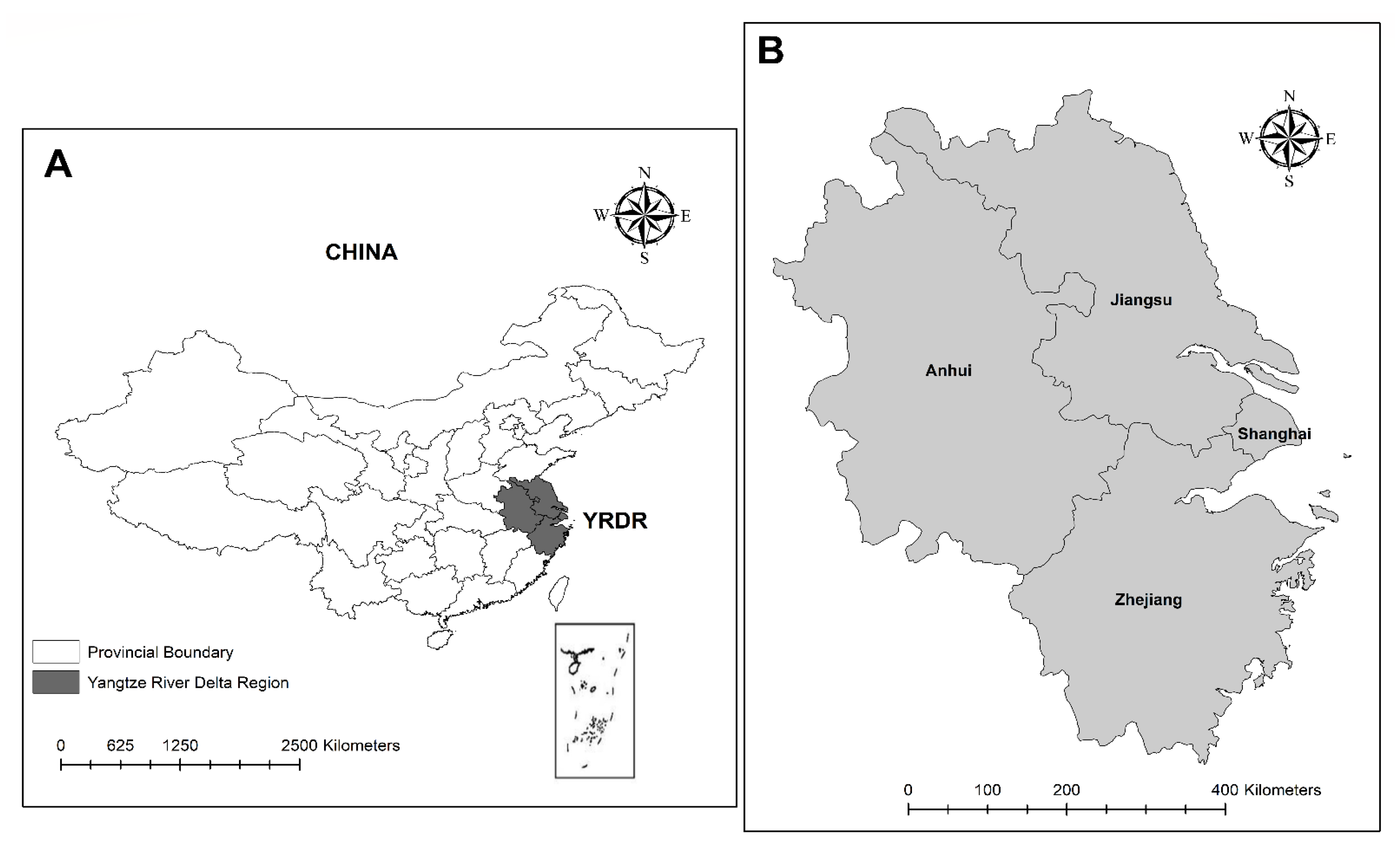
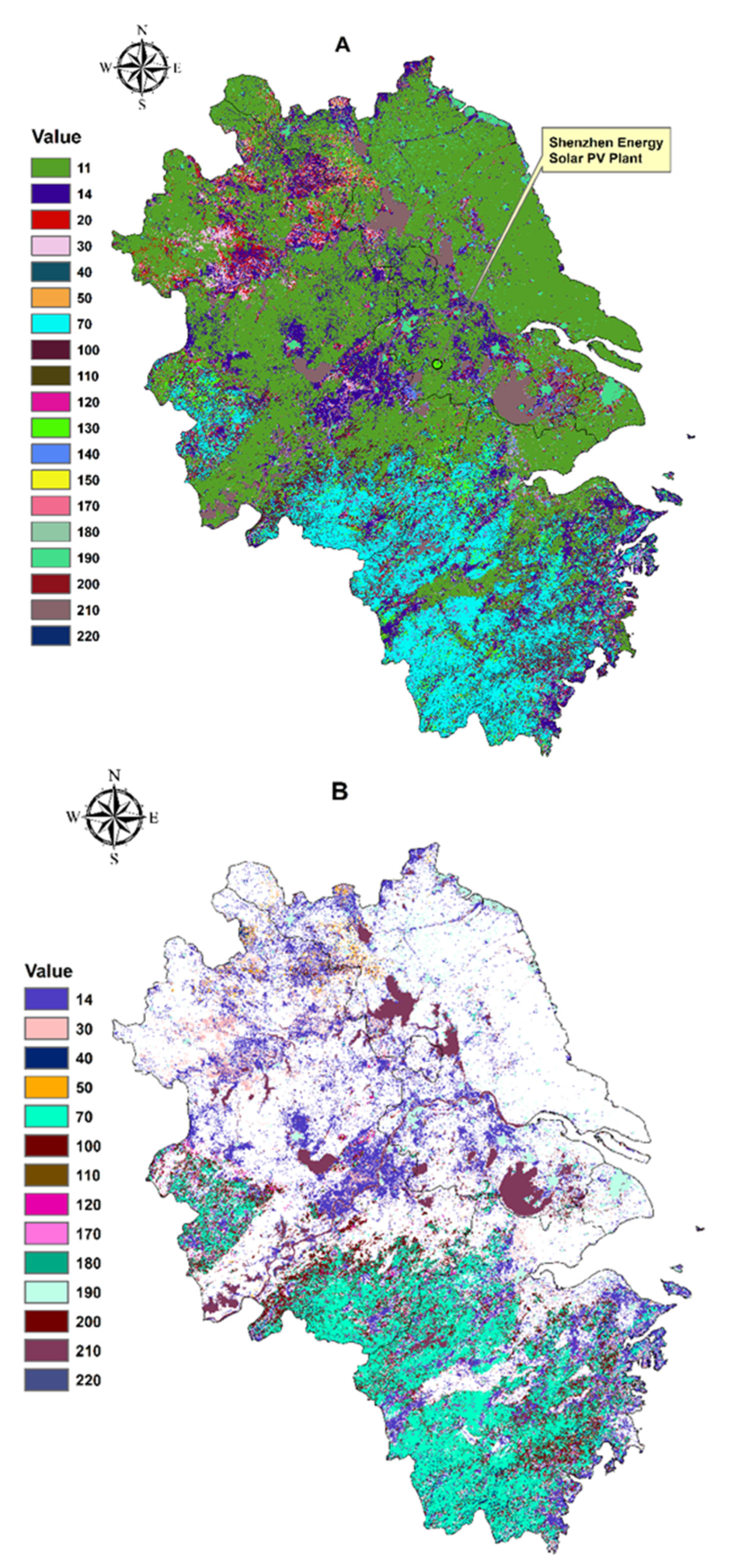

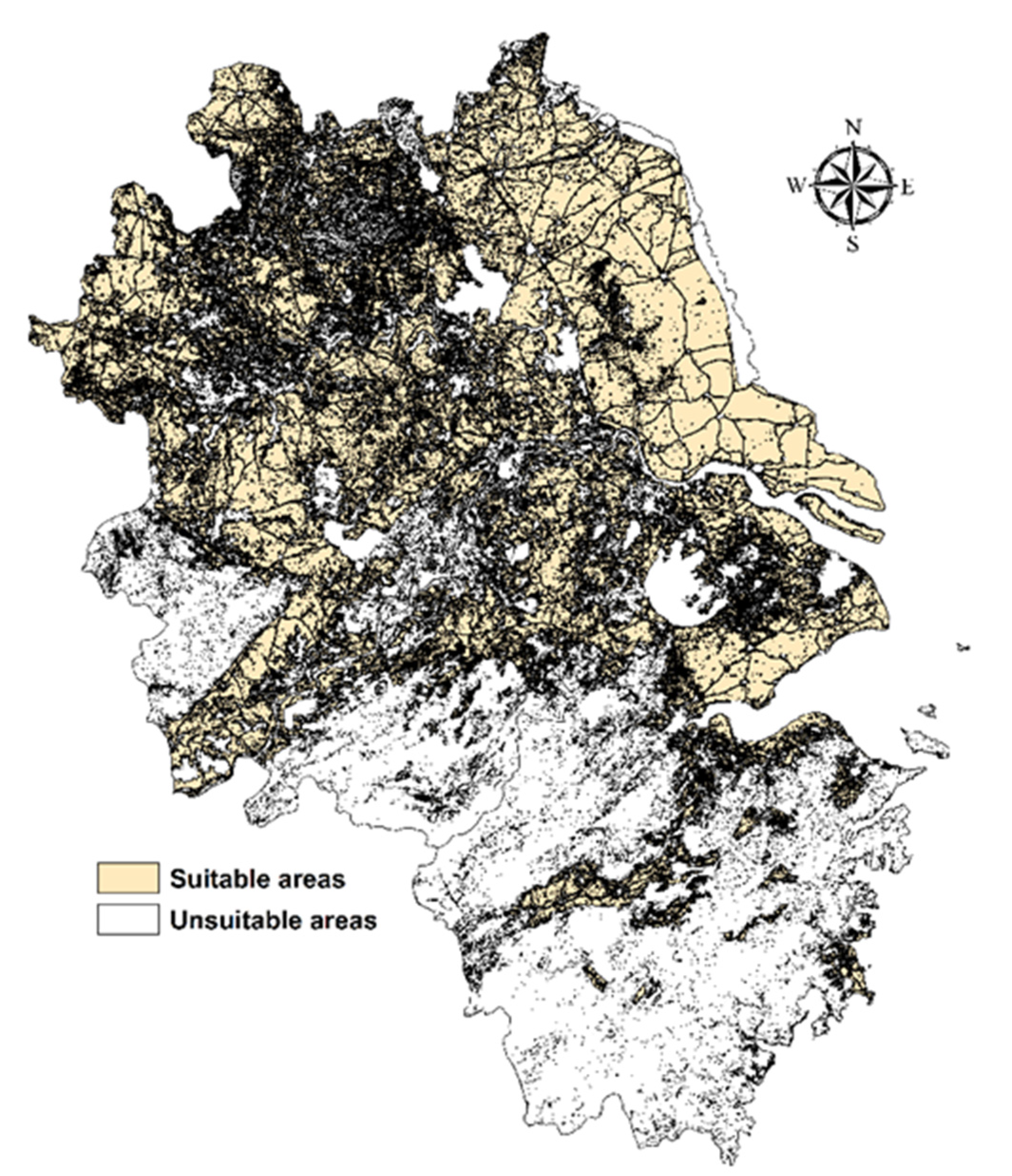
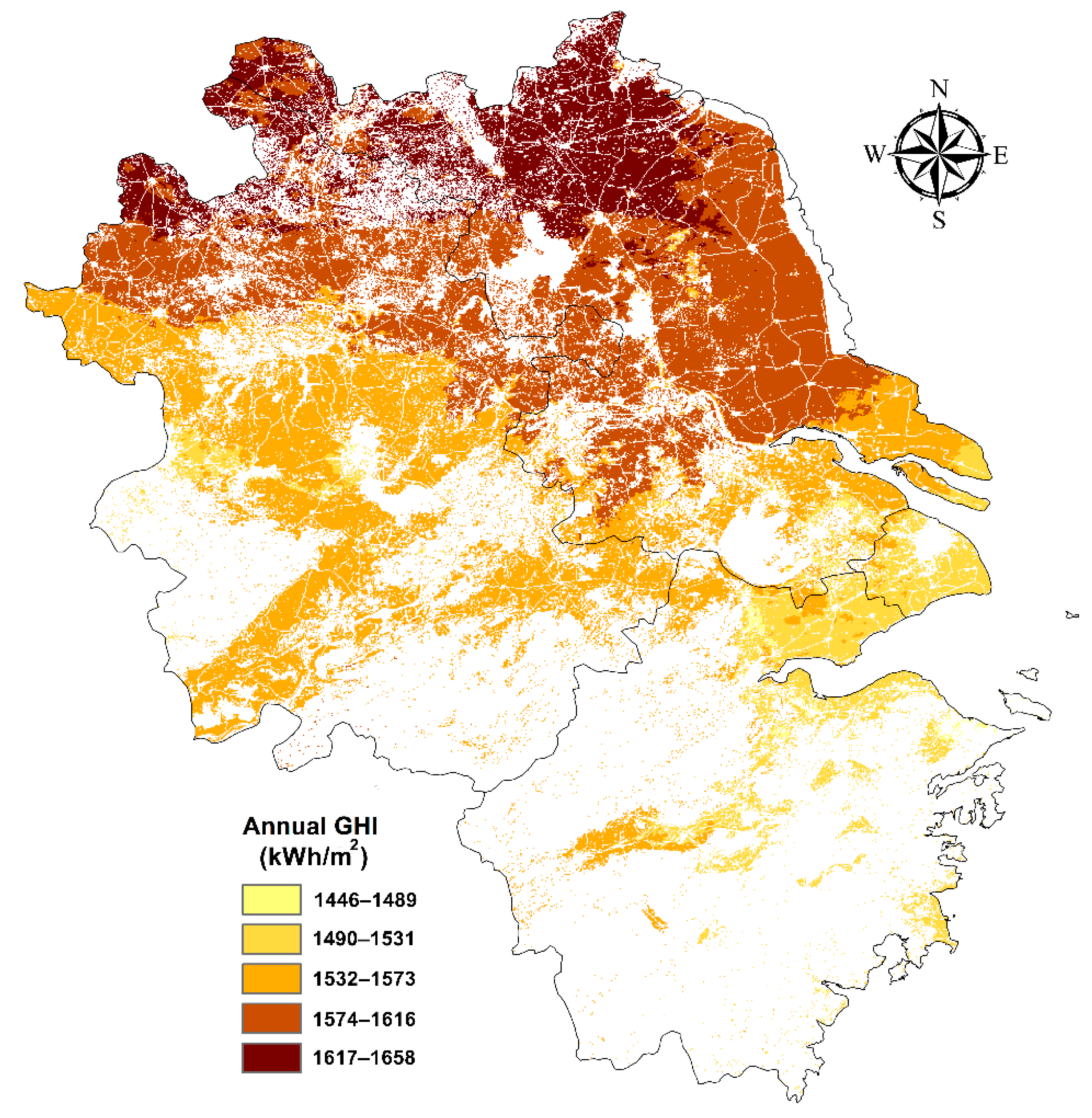
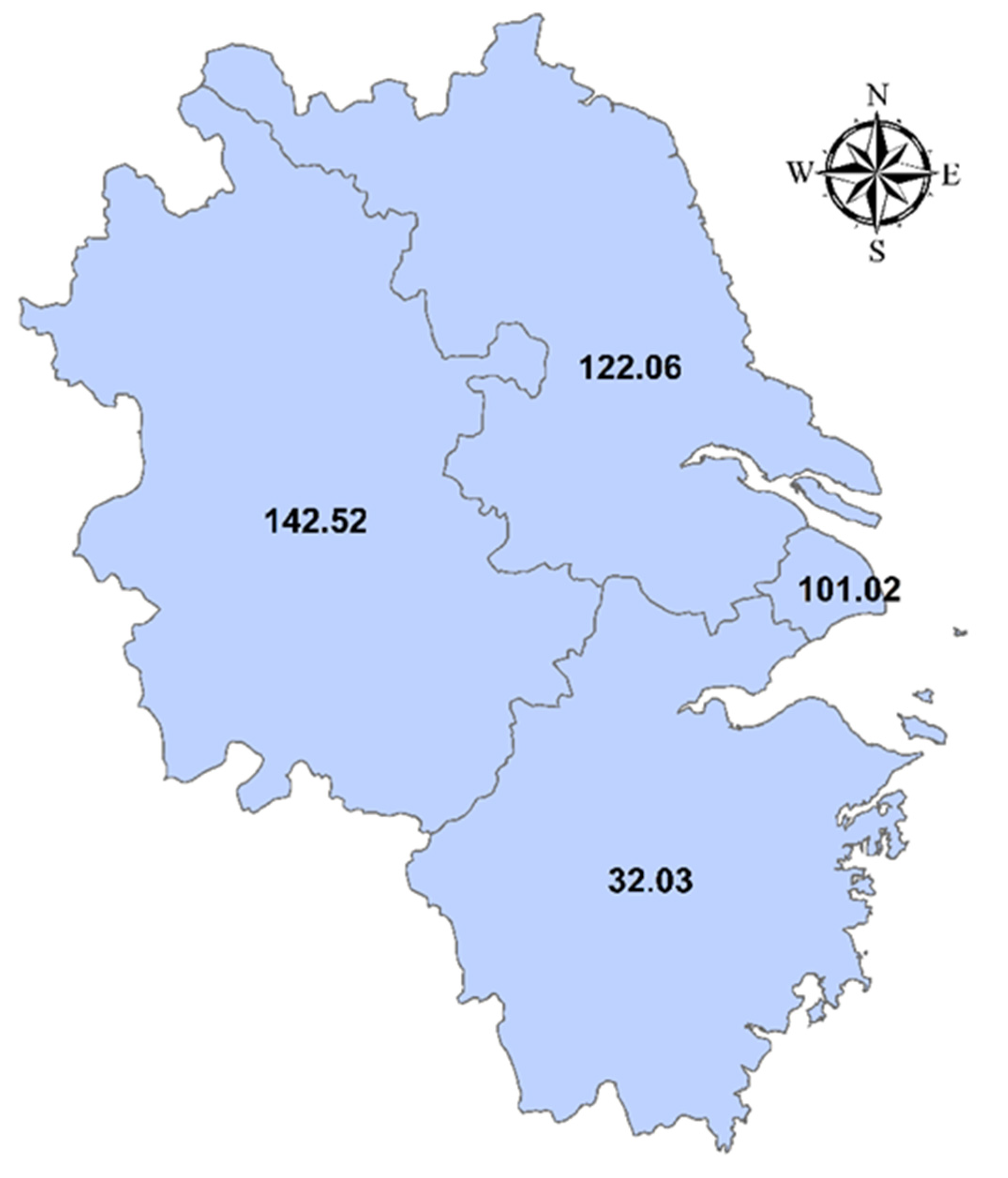
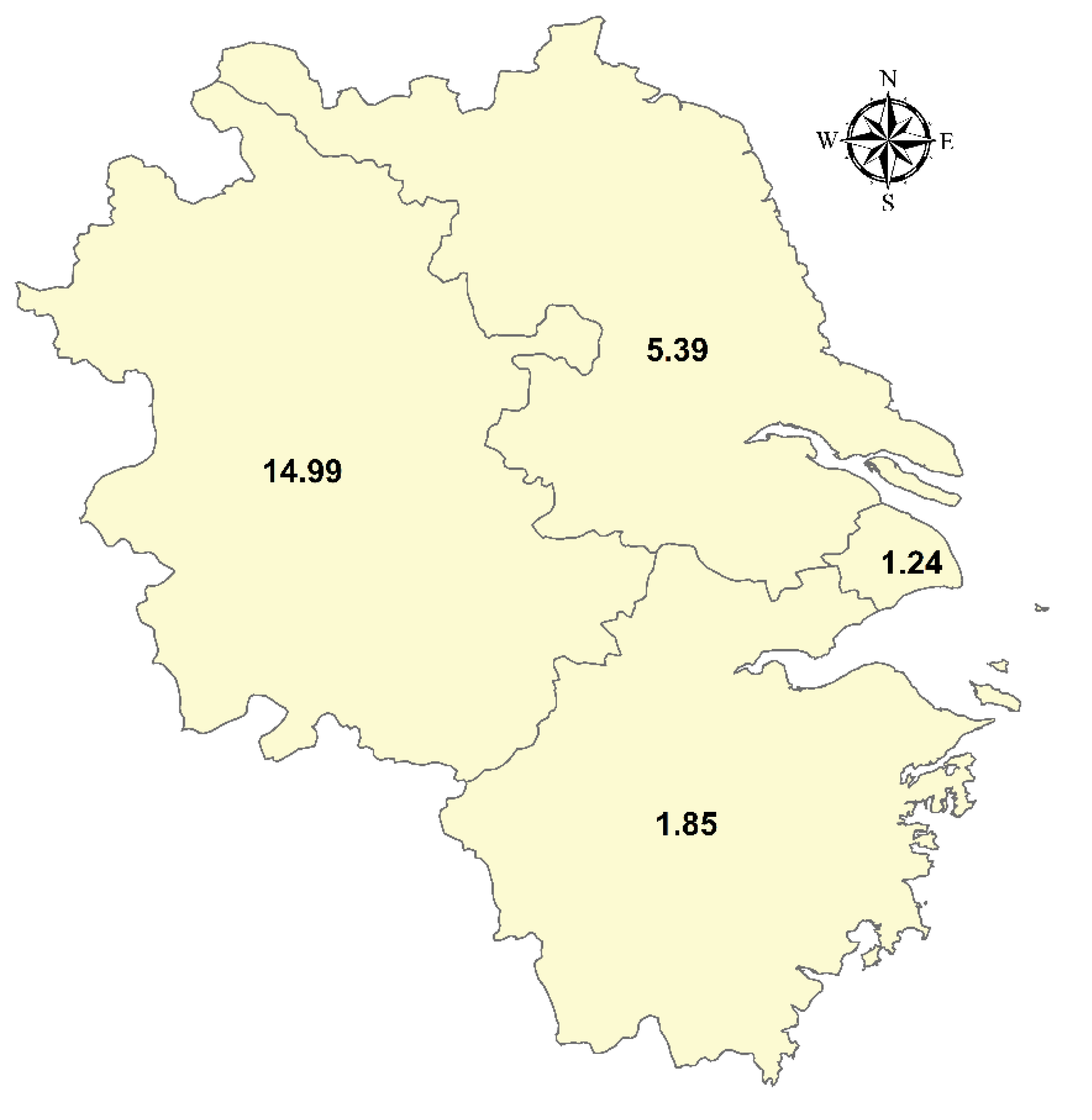

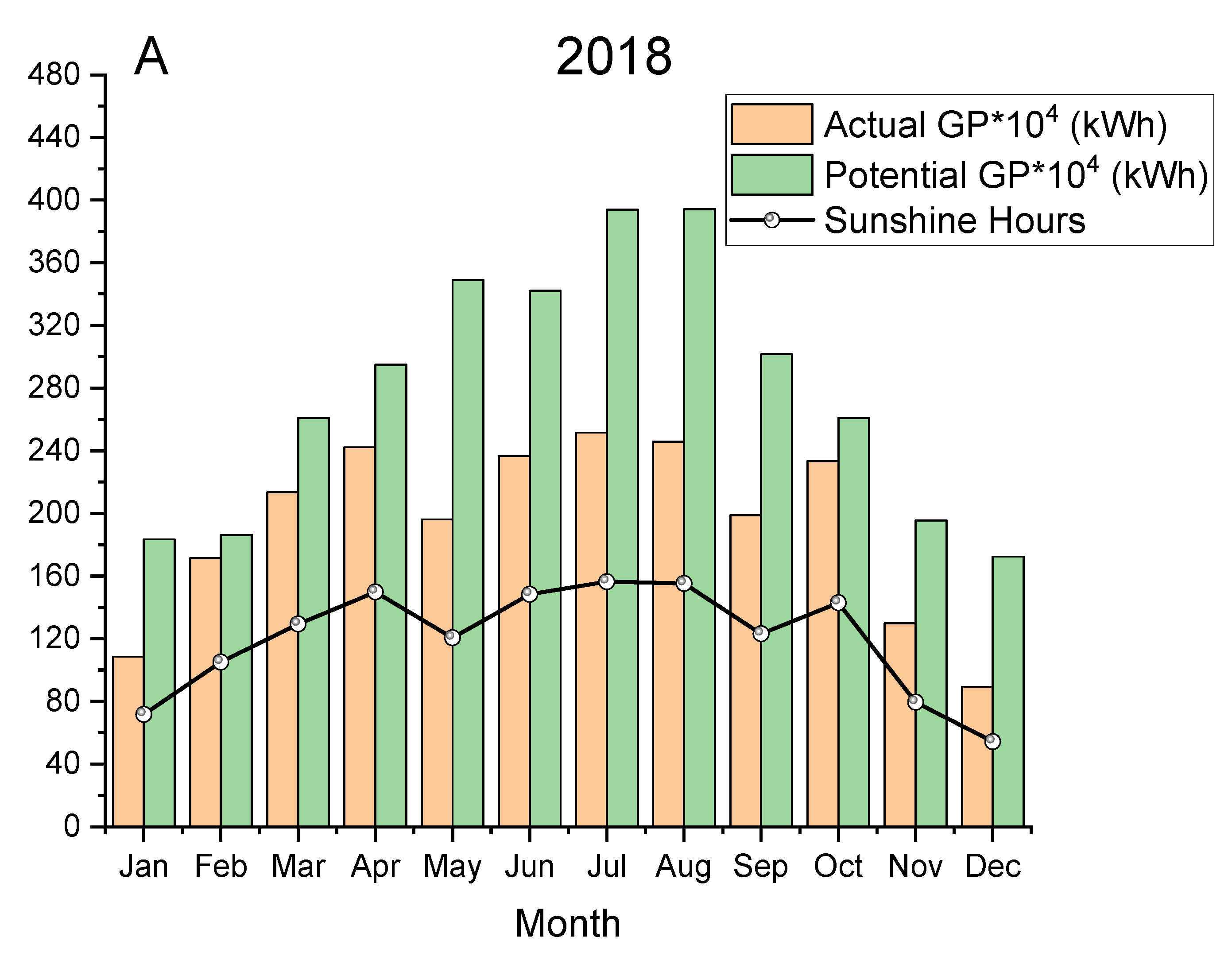
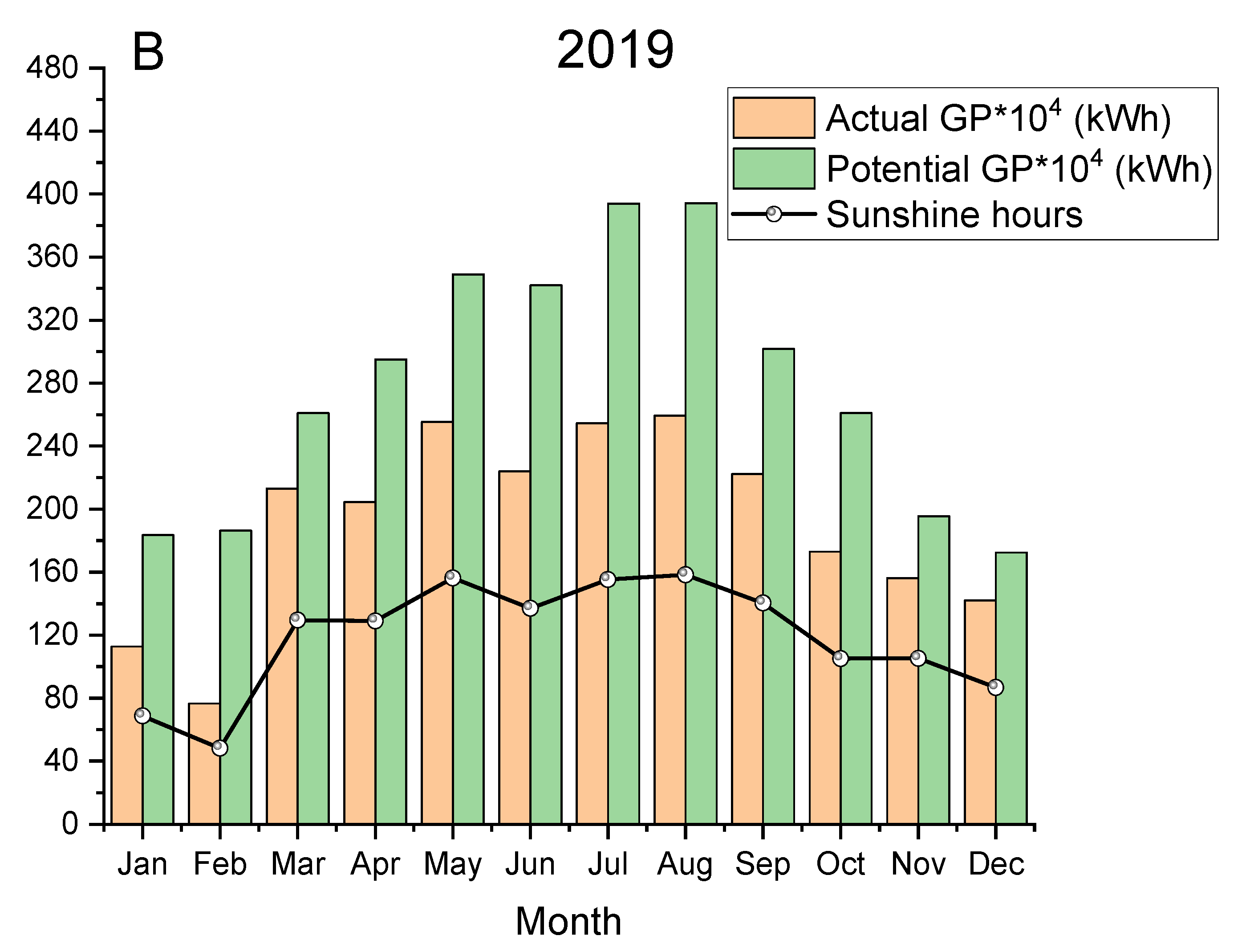
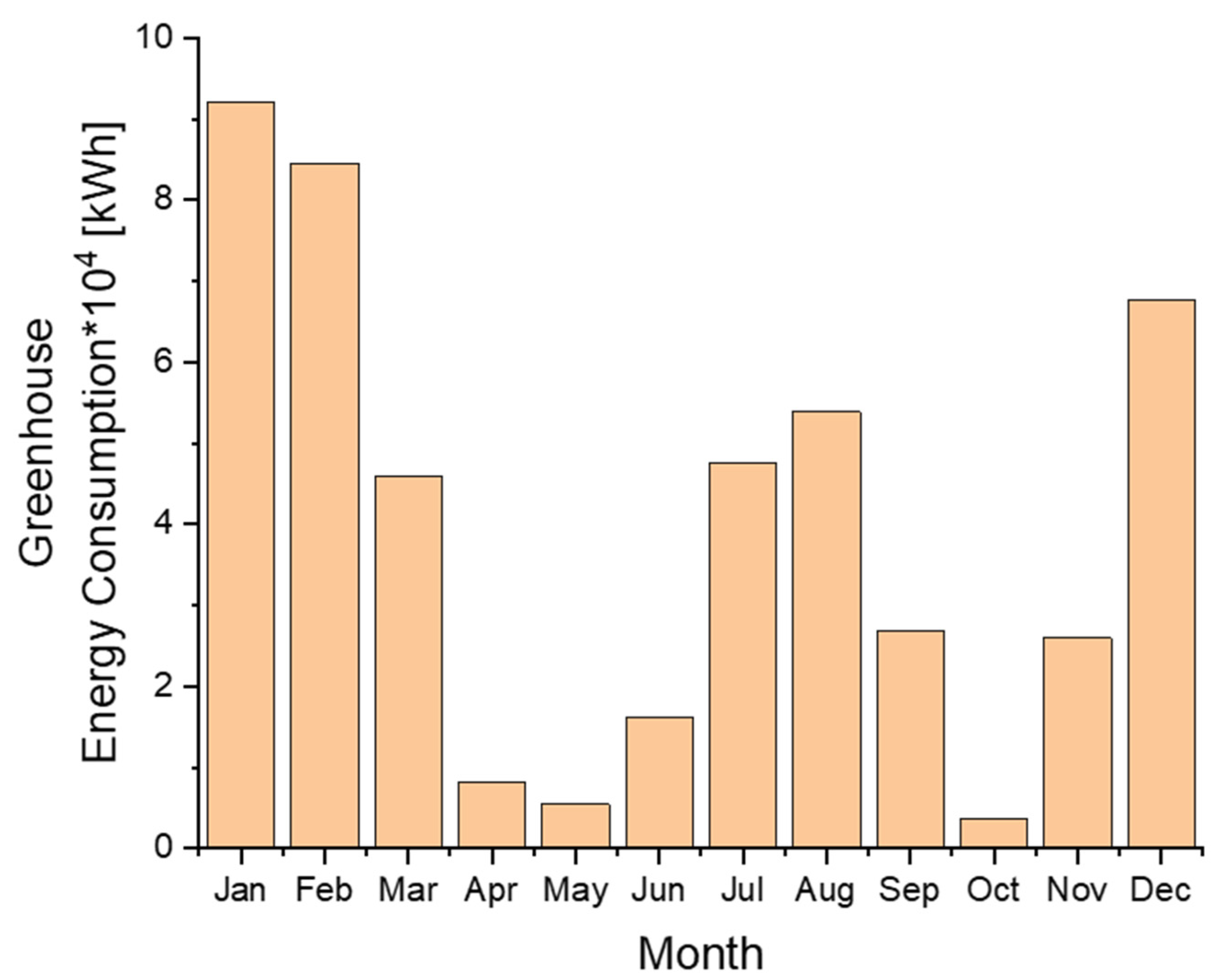
| Value | GlobCover Legend |
|---|---|
| 11 | Irrigated croplands (or aquatic) |
| 14 | Rainfed croplands |
| 20 | Mosaic cropland (50–70%)/vegetation (grassland/shrubland/forest) (20–50%) |
| 30 | Mosaic vegetation (grassland/shrubland/forest) (50–70%)/cropland (20–50%) |
| 40 | Closed to open (>15%) broadleaved evergreen or semi-deciduous forest (>5 m) |
| 50 | Closed (>40%) broadleaved deciduous forest (>5 m) |
| 70 | Closed (>40%) needle-leaved evergreen forest (>5 m) |
| 100 | Closed to open (>15%) mixed broadleaved and needle-leaved forest (>5 m) |
| 110 | Mosaic forest or shrubland (50–70%)/grassland (20–50%) |
| 120 | Mosaic grassland (50–70%)/forest or shrubland (20–50%) |
| 130 | Closed to open (>15%) (broadleaved or needle-leaved, evergreen or deciduous) shrubland (<5 m) |
| 140 | Closed to open (>15%) herbaceous vegetation (grassland, savannas or lichens/mosses) |
| 150 | Sparse (<15%) vegetation |
| 170 | Closed (>40%) broadleaved forest or shrubland permanently flooded—saline or brackish water |
| 180 | Closed to open (>15%) grassland or woody vegetation on regularly flooded or waterlogged soil—fresh, brackish or saline water |
| 190 | Artificial surfaces and associated areas (urban areas >50%) |
| 200 | Bare areas |
| 210 | Water bodies |
| 220 | Permanent snow and ice |
| Theme | Dataset |
|---|---|
| Digital elevation model (DEM) | NASA SRTM 90 m, version 4 [29] |
| Administrative boundary | GADM, version 3.6 [30] |
| Water bodies | WWF [31] |
| Protected areas | WDPA [32] |
| Urban built-up areas | Natural Earth [33] |
| Road and Rail networks | DIVA-GIS [34] |
| Land use land cover | GlobCover [35] |
| Administrative Division | Suitable Area (km2) | 1 Total Land Area (km2) | Proportion of Suitable Area to the Total Suitable Area (%) | Proportion of Suitable Area to Total Land Area (%) |
|---|---|---|---|---|
| Anhui | 64,370.97 | 140,627.14 | 43.17 | 45.77 |
| Jiangsu | 65,330.24 | 99,965.79 | 43.81 | 65.35 |
| Shanghai | 3965.75 | 5943.96 | 2.66 | 66.71 |
| Zhejiang | 15,450.49 | 100,277.12 | 10.36 | 15.41 |
| Total area | 149,117.45 | 346,814.01 | - | - |
Publisher’s Note: MDPI stays neutral with regard to jurisdictional claims in published maps and institutional affiliations. |
© 2020 by the authors. Licensee MDPI, Basel, Switzerland. This article is an open access article distributed under the terms and conditions of the Creative Commons Attribution (CC BY) license (http://creativecommons.org/licenses/by/4.0/).
Share and Cite
Odhiambo, M.R.O.; Abbas, A.; Wang, X.; Mutinda, G. Solar Energy Potential in the Yangtze River Delta Region—A GIS-Based Assessment. Energies 2021, 14, 143. https://doi.org/10.3390/en14010143
Odhiambo MRO, Abbas A, Wang X, Mutinda G. Solar Energy Potential in the Yangtze River Delta Region—A GIS-Based Assessment. Energies. 2021; 14(1):143. https://doi.org/10.3390/en14010143
Chicago/Turabian StyleOdhiambo, Morice R. O., Adnan Abbas, Xiaochan Wang, and Gladys Mutinda. 2021. "Solar Energy Potential in the Yangtze River Delta Region—A GIS-Based Assessment" Energies 14, no. 1: 143. https://doi.org/10.3390/en14010143
APA StyleOdhiambo, M. R. O., Abbas, A., Wang, X., & Mutinda, G. (2021). Solar Energy Potential in the Yangtze River Delta Region—A GIS-Based Assessment. Energies, 14(1), 143. https://doi.org/10.3390/en14010143






